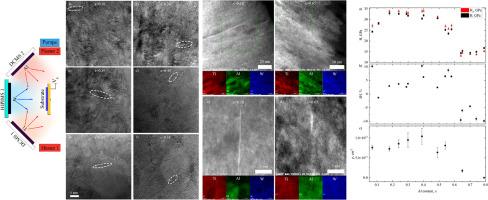Guinier-Preston zone hardening during vacuum annealing of (Ti1-xAlx)0.92W0.08N (0.07 ≤ x ≤ 0.79) thin films
IF 8.3
1区 材料科学
Q1 MATERIALS SCIENCE, MULTIDISCIPLINARY
引用次数: 0
Abstract
We present a systematic study on the formation of Guinier-Preston (GP) zones and corresponding age hardening in metastable cubic (Ti1-xAlx)0.92W0.08N thin films at annealing temperatures relevant to cutting tool applications. The Al content, which determines the compound's phase stability, varies widely from x = 0.07 to 0.79. The density of GP zones forming after 2 h long annealing in vacuum at 950 °C is assessed by cross-sectional transmission electron microscopy. Concurrent to the spinodal decomposition of c-(Ti,Al,W)N into c-Ti(W)N and c-Al(W)N, tungsten forms atomic-plane-thick W disks on (111) planes of the cubic matrix. The density of GP zones is ∼ 6.3·1011 – 1.2·1012 cm−2 in the 0.07 ≤ x ≤ 0.58 range and decreases to 1.8·1011 cm−2 with х = 0.65 concomitant with precipitation of w-AlN grains and bcc-W nanocrystallites. GP zone formation and age hardening is observed for all films with 0.07 ≤ x ≤ 0.58 with 2 to 14 % increase in hardness, starting from high levels between 23.5 and 32.9 GPa. Elevated hardness is, thus, retained over the entire temperature range: 520 to 950 °C. Finally, precipitation of bcc-W at х ≥ 0.65 during annealing above 950 °C is observed as a means to relax misfit strain between the c-Ti(W)N and w-Al(W)N components.


求助全文
约1分钟内获得全文
求助全文
来源期刊

Acta Materialia
工程技术-材料科学:综合
CiteScore
16.10
自引率
8.50%
发文量
801
审稿时长
53 days
期刊介绍:
Acta Materialia serves as a platform for publishing full-length, original papers and commissioned overviews that contribute to a profound understanding of the correlation between the processing, structure, and properties of inorganic materials. The journal seeks papers with high impact potential or those that significantly propel the field forward. The scope includes the atomic and molecular arrangements, chemical and electronic structures, and microstructure of materials, focusing on their mechanical or functional behavior across all length scales, including nanostructures.
 求助内容:
求助内容: 应助结果提醒方式:
应助结果提醒方式:


